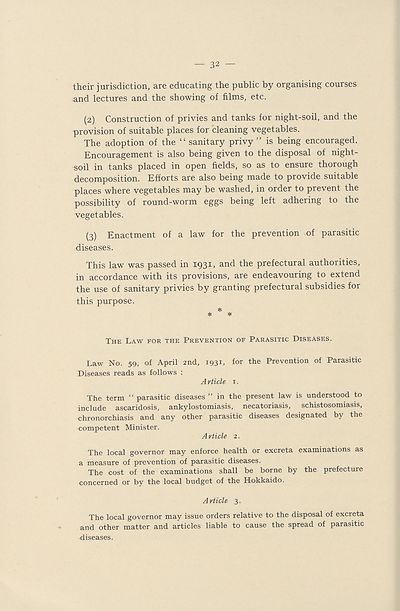Health > Intergovernmental conference of Far-Eastern countries on rural hygiene : preparatory papers : report of Japan
(34)
Download files
Complete book:
Individual page:
Thumbnail gallery: Grid view | List view

— 32 —
their jurisdiction, are educating the public by organising courses
and lectures and the showing of films, etc.
(2) Construction of privies and tanks for night-soil, and the
provision of suitable places for cleaning vegetables.
The adoption of the “ sanitary privy ” is being encouraged.
Encouragement is also being given to the disposal of night-
soil in tanks placed in open fields, so as to ensure thorough
decomposition. Efforts are also being made to provide suitable
places where vegetables may be washed, in order to prevent the
possibility of round-worm eggs being left adhering to the
vegetables.
(3) Enactment of a law for the prevention of parasitic
diseases.
This law was passed in 1931, and the prefectural authorities,
in accordance with its provisions, are endeavouring to extend
the use of sanitary privies by granting prefectural subsidies for
this purpose.
*
* *
The Law for the Prevention of Parasitic Diseases.
Law No. 59, of April 2nd, 1931, for the Prevention of Parasitic
Diseases reads as follows :
A Hide 1.
The term “ parasitic diseases ” in the present law is understood to
include ascaridosis, ankylostomiasis, necatoriasis, schistosomiasis,
chronorchiasis and any other parasitic diseases designated by the
competent Minister.
Artide 2.
The local governor may enforce health or excreta examinations as
a measure of prevention of parasitic diseases.
The cost of the examinations shall be borne by the prefecture
concerned or by the local budget of the Hokkaido.
Artide 3.
The local governor may issue orders relative to the disposal of excreta
and other matter and articles liable to cause the spread of parasitic
diseases.
their jurisdiction, are educating the public by organising courses
and lectures and the showing of films, etc.
(2) Construction of privies and tanks for night-soil, and the
provision of suitable places for cleaning vegetables.
The adoption of the “ sanitary privy ” is being encouraged.
Encouragement is also being given to the disposal of night-
soil in tanks placed in open fields, so as to ensure thorough
decomposition. Efforts are also being made to provide suitable
places where vegetables may be washed, in order to prevent the
possibility of round-worm eggs being left adhering to the
vegetables.
(3) Enactment of a law for the prevention of parasitic
diseases.
This law was passed in 1931, and the prefectural authorities,
in accordance with its provisions, are endeavouring to extend
the use of sanitary privies by granting prefectural subsidies for
this purpose.
*
* *
The Law for the Prevention of Parasitic Diseases.
Law No. 59, of April 2nd, 1931, for the Prevention of Parasitic
Diseases reads as follows :
A Hide 1.
The term “ parasitic diseases ” in the present law is understood to
include ascaridosis, ankylostomiasis, necatoriasis, schistosomiasis,
chronorchiasis and any other parasitic diseases designated by the
competent Minister.
Artide 2.
The local governor may enforce health or excreta examinations as
a measure of prevention of parasitic diseases.
The cost of the examinations shall be borne by the prefecture
concerned or by the local budget of the Hokkaido.
Artide 3.
The local governor may issue orders relative to the disposal of excreta
and other matter and articles liable to cause the spread of parasitic
diseases.
Set display mode to:
![]() Universal Viewer |
Universal Viewer | ![]() Mirador |
Large image | Transcription
Mirador |
Large image | Transcription
Images and transcriptions on this page, including medium image downloads, may be used under the Creative Commons Attribution 4.0 International Licence unless otherwise stated. ![]()
| League of Nations > Health > Intergovernmental conference of Far-Eastern countries on rural hygiene : preparatory papers : report of Japan > (34) |
|---|
| Permanent URL | https://digital.nls.uk/191077961 |
|---|
| Shelfmark | LN.III |
|---|---|
| Description | Over 1,200 documents from the non-political organs of the League of Nations that dealt with health, disarmament, economic and financial matters for the duration of the League (1919-1945). Also online are statistical bulletins, essential facts, and an overview of the League by the first Secretary General, Sir Eric Drummond. These items are part of the Official Publications collection at the National Library of Scotland. |
|---|---|
| Additional NLS resources: |
|

